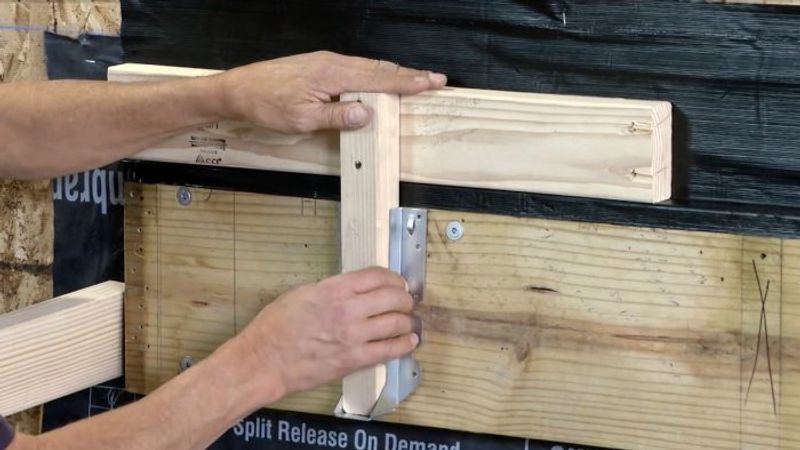Installing Deck Joists
With joist hangers, it’s all about placement, flange style, and proper fastening.

Jump to all the videos in this series
Joist hangers straddle the ends of the joists at the ledger and along a rim beam at the outside of a deck if one is used instead of a dropped beam. Joist hangers and their fasteners transfer the vertical load on the joists to the ledger and rim beam, keep the joists from rolling over sideways, resist uplift load at the ledger when there is a cantilevered portion at the other end, and the diagonal fasteners help resist withdrawal of the joist from the hanger.
Because of their importance to the stability and safety of a deck, joist hangers and their fasteners have to be installed according to the manufacturers’ instructions.
Joist-hanger sizing
Select the right sized hanger for the joists you’re installing. Manufacturers make hangers for common dimensional lumber sizes – 2×4, 2×6, 2×8…. Joist hangers are sized about 1 in. shorter than the dimensional lumber depth – a 2×10 is about 9-1/4 in. tall when dry and a 2×10 joist hanger is about 8 in. tall. You can also use shorter hangers – say a 2×6 hanger on a 2×8 joist. This is permitted as long as the sides of the hanger straddle 60% of the joist height and the dead plus live loads on the deck don’t exceed the hanger capacity. Manufacturers sometimes label hangers to fit two size joists (2×6 – 2×8 and 2×10 – 2×12).
Use concealed flange / inverted flange hangers to support the end joists on a deck. Since the flanges are turned inward and the fasteners driven in the joist pocket the joists will have to be cut shorter than the joists installed with regular flange hangers.
Joist-hanger fastener selection
Use the right fasteners – type and diameter, length and metal. Only framing type common nails are permitted to be used. Roofing, drywall, concrete and siding nails are not permitted. Shank diameter – generally 10d (0.148 in.) is required for joist hangers. Don’t use nails with smaller (0.133) diameter like sinkers or box nails . Length is important and will be dictated by the manufacturer and location of the nail. The face nails driven square into the ledger are generally 1-1/2 in. long. The diagonal nails must be at least 3 in. long (full 10d) in order to penetrate deep enough into the ledger or rim beam to provide the full uplift and gravity load capacities for the hanger. And don’t mix metals. Galvanized hardware must be installed with galvanized fasteners and stainless steel with stainless fasteners.
Screws can be used to install joist hangers but they have to be the right structural connector screws. Decking screws, drywall screws and wood screws are not permitted. Connector screws are relatively new and can be handy especially in hard to access area where it’s hard to swing a hammer or fit a nailer in. And since structural connector screws are brand-specific, make sure to use those supplied by the maker of the joist hangers or other metal hardware you are using.
Pneumatic or cordless nailers designed for installing metal connector nails can be used. Just make sure the indexing tip is positioned in the hanger hole before firing. Nails driven through the hardware will damage it.
The rim joist can be fastened to the ends of the joists with 3 – 10d galvanized nails but the nails can pull out over time and the joists can then twist. A more secure alternative is to use structural screws – like the ones used to attach a ledger to the house. There’s no prescriptive length guide for screwing rather than nailing on the rim joist. But if you will be mounting guardrail posts to the rim board using screw and blocking details, check with the screw manufacturer’s instructions for screw length for joists adjacent to the posts.
The IRC calls for joists to be fastened to the beam with 4 – 8d galvanized nails or metal connectors. Building departments in seismic, high wind and flood zones may require metal connectors to secure the joists to the beam.
Fastener corrosion resistance
Make sure all metal hardware used on decks are galvanized to the level required for outdoor use with pressure treated lumber (G-185) or stainless steel to resist corrosion.
Deck-joist articles and videos
- How to Install a Joist Hanger
- What type of joist hangers should I use with pressure treated wood?
- Get Your Deck Joists Right
- Critical Deck Connections
Joist-fastener product information
MiTek/USP product information
Videos in the Series
-
How to Install and Flash a Deck Ledger, Start to Finish
-
Options for Fastening a Deck Ledger
-
Attach a Deck Ledger Over Brick, Foam, and Other Thick Claddings
-
Deck Footing Options
-
Options for Fastening Deck Posts to Footings
-
Options for Fastening Beams to Deck Posts
-
Installing Deck Joists
-
Lateral Load Deck Connector Options
-
Options for Fastening Deck Guardrails
-
Building Strong Deck Stairs














